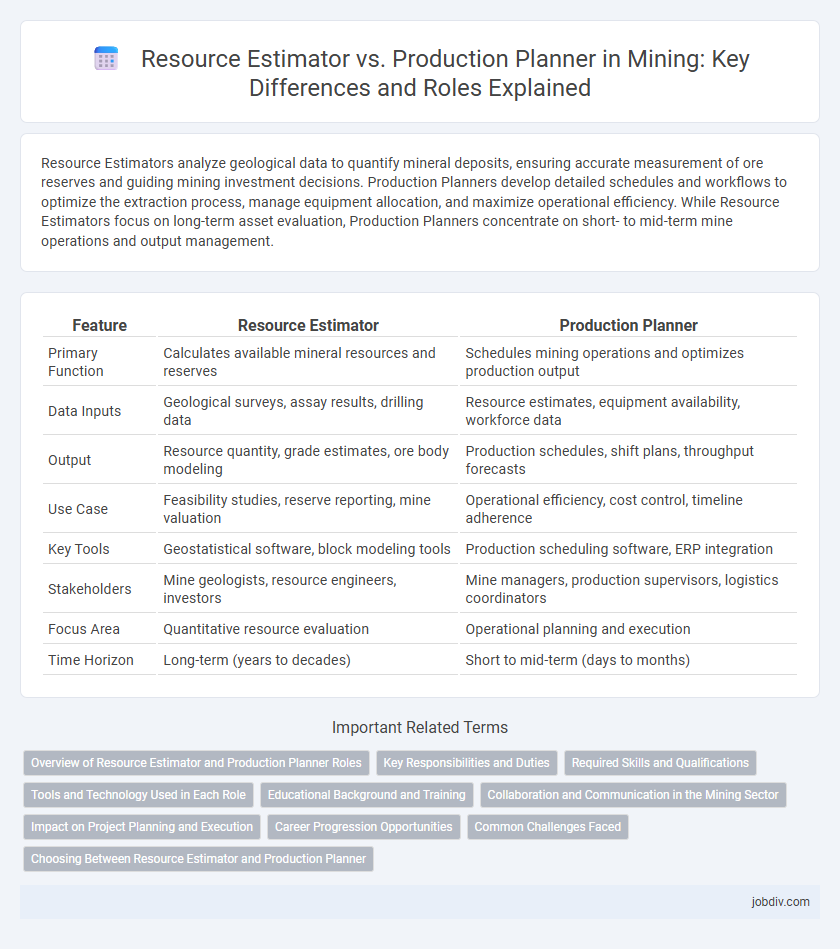Resource Estimators analyze geological data to quantify mineral deposits, ensuring accurate measurement of ore reserves and guiding mining investment decisions. Production Planners develop detailed schedules and workflows to optimize the extraction process, manage equipment allocation, and maximize operational efficiency. While Resource Estimators focus on long-term asset evaluation, Production Planners concentrate on short- to mid-term mine operations and output management.
Table of Comparison
| Feature | Resource Estimator | Production Planner |
|---|---|---|
| Primary Function | Calculates available mineral resources and reserves | Schedules mining operations and optimizes production output |
| Data Inputs | Geological surveys, assay results, drilling data | Resource estimates, equipment availability, workforce data |
| Output | Resource quantity, grade estimates, ore body modeling | Production schedules, shift plans, throughput forecasts |
| Use Case | Feasibility studies, reserve reporting, mine valuation | Operational efficiency, cost control, timeline adherence |
| Key Tools | Geostatistical software, block modeling tools | Production scheduling software, ERP integration |
| Stakeholders | Mine geologists, resource engineers, investors | Mine managers, production supervisors, logistics coordinators |
| Focus Area | Quantitative resource evaluation | Operational planning and execution |
| Time Horizon | Long-term (years to decades) | Short to mid-term (days to months) |
Overview of Resource Estimator and Production Planner Roles
Resource Estimators analyze geological data and mine design specifics to calculate the quantity and quality of extractable minerals, ensuring accurate resource assessments for feasible project planning. Production Planners develop detailed schedules and workflow strategies to optimize mining operations, balancing equipment usage, labor allocation, and output targets. Both roles are essential for maximizing efficiency and profitability in mining projects, with Resource Estimators focusing on resource quantification and Production Planners on operational execution.
Key Responsibilities and Duties
Resource Estimators analyze geological data and quantify mineral reserves to provide accurate resource evaluations critical for feasibility studies and reporting. Production Planners develop and schedule mining operations, optimizing equipment use, workforce allocation, and material flow to meet production targets efficiently. Both roles collaborate to ensure alignment between estimated resources and planned extraction, enhancing operational efficiency and cost control.
Required Skills and Qualifications
Resource Estimators in mining require strong proficiency in geology, data analysis, and software like Surpac or Datamine to assess mineral quantities accurately. Production Planners need expertise in operational scheduling, supply chain management, and knowledge of mining equipment to optimize extraction processes. Both roles demand a background in mining engineering or geology, with advanced problem-solving skills and experience in industry-specific software.
Tools and Technology Used in Each Role
Resource Estimators utilize geological modeling software such as Surpac, Datamine, and Vulcan to analyze mineral deposits and calculate reserves with precision. Production Planners rely on scheduling tools like MineSched, Microsoft Project, and specialized ERP systems to optimize daily operations, equipment allocation, and manpower management. Advanced data analytics and real-time monitoring technologies integrate into both roles to enhance decision-making and operational efficiency in mining projects.
Educational Background and Training
Resource estimators in mining typically hold degrees in geology, mining engineering, or geostatistics, with specialized training in resource modeling and reserve estimation software. Production planners often possess backgrounds in mining or industrial engineering, emphasizing operational logistics and production scheduling, complemented by training in mine planning software and optimization techniques. Both roles require continuous education in emerging technologies and regulatory compliance to ensure efficient and sustainable mine operations.
Collaboration and Communication in the Mining Sector
Resource estimators and production planners in the mining sector must maintain seamless collaboration and clear communication to ensure accurate forecasting and efficient operational scheduling. Effective information sharing about geological data, production capacities, and market demand enables optimized resource allocation and reduces project risks. Streamlined communication channels between these roles enhance decision-making processes, promoting cost efficiency and maximizing mineral extraction.
Impact on Project Planning and Execution
Resource estimators provide detailed quantification of mineral reserves and grade distribution, enabling accurate budgeting and risk assessment in mining projects. Production planners translate these estimates into operational schedules, optimizing equipment allocation, workforce deployment, and processing throughput to maximize output. Effective collaboration between resource estimators and production planners enhances project timelines, cost control, and overall operational efficiency in mining ventures.
Career Progression Opportunities
Resource Estimators specialize in evaluating mineral deposits and quantifying extractable resources, laying the groundwork for economic feasibility studies. Production Planners advance by integrating geological data with operational logistics to optimize mining schedules and equipment utilization, directly impacting profitability. Career progression often transitions from detailed resource assessment roles into strategic planning positions, emphasizing increased responsibility in project management and operational efficiency.
Common Challenges Faced
Resource estimators and production planners in mining frequently encounter challenges such as data accuracy and integration, which directly impact the reliability of forecasts and operational efficiency. Both roles struggle with aligning geological variability and market demand fluctuations, complicating scheduling and resource allocation. Coordination gaps and inconsistent software tools further exacerbate these difficulties, hindering seamless communication and decision-making processes.
Choosing Between Resource Estimator and Production Planner
Choosing between a Resource Estimator and a Production Planner hinges on the specific mining project phase: Resource Estimators focus on quantifying mineral deposits using geological data, ensuring accurate reserve calculations essential for feasibility studies. Production Planners concentrate on scheduling and optimizing extraction processes, balancing equipment, labor, and operational costs to maximize mine output. Effective decision-making requires aligning the chosen role with the project's goals, whether prioritizing detailed resource assessment or efficient production management.
Resource Estimator vs Production Planner Infographic

 jobdiv.com
jobdiv.com